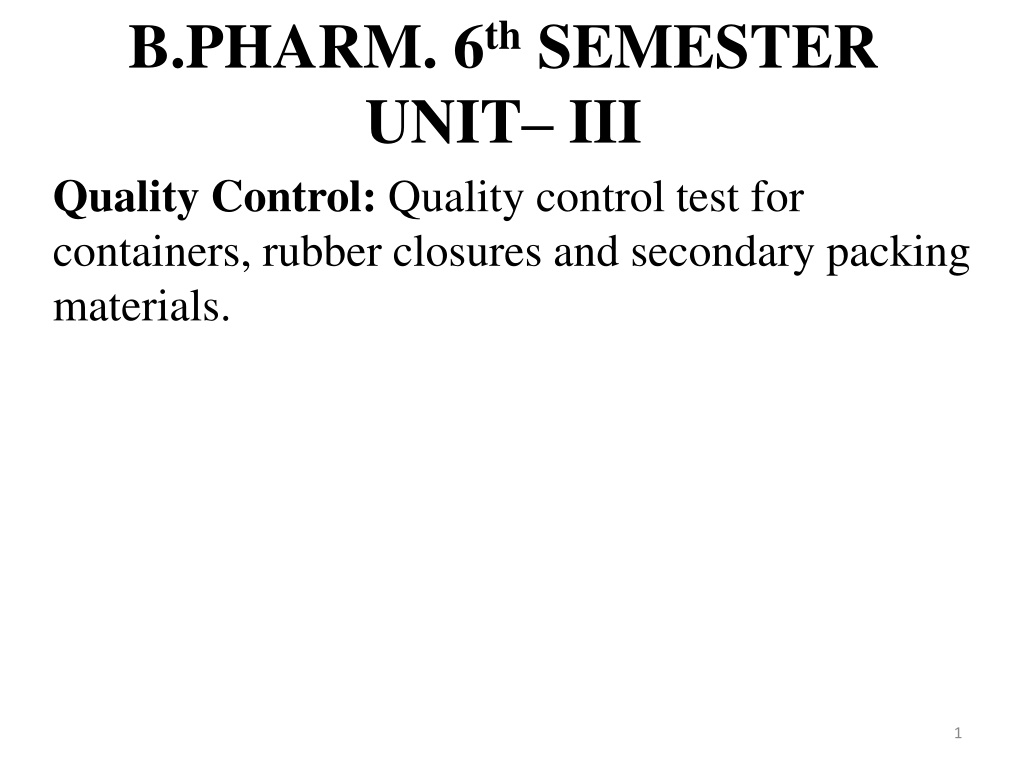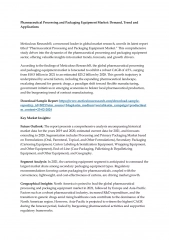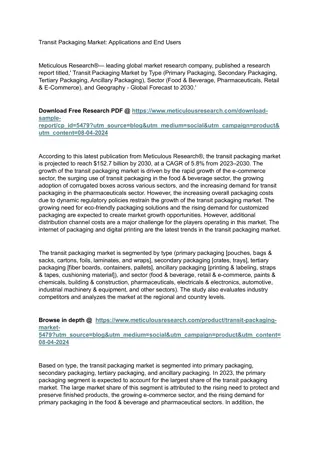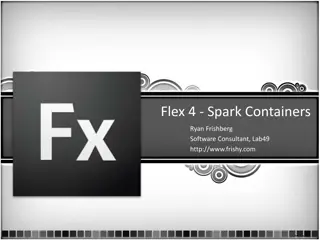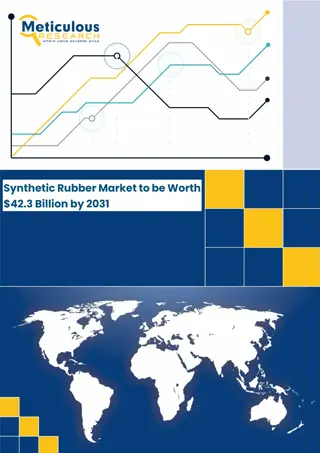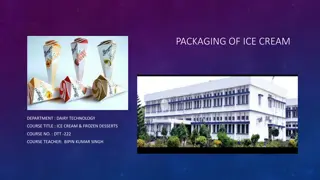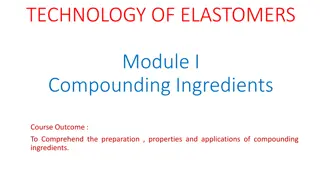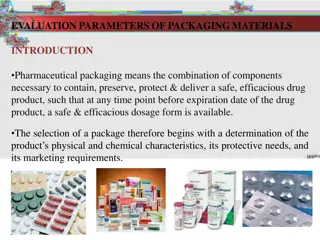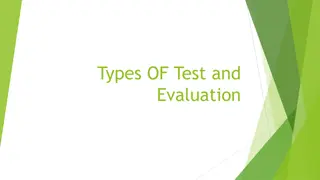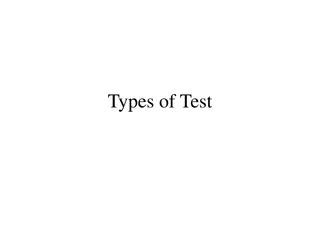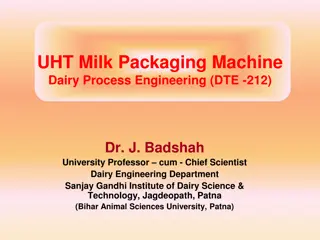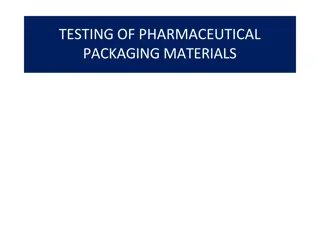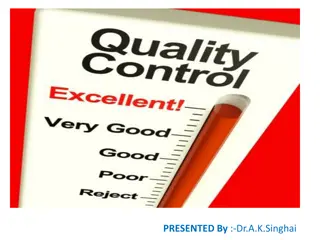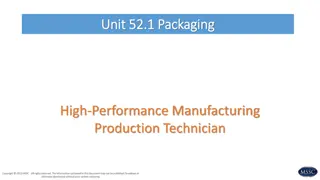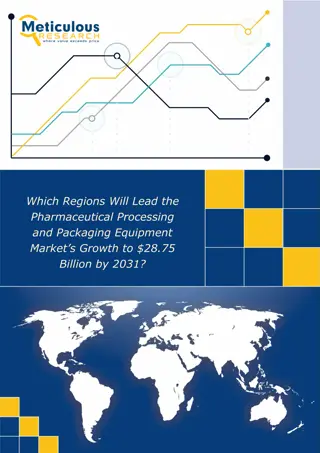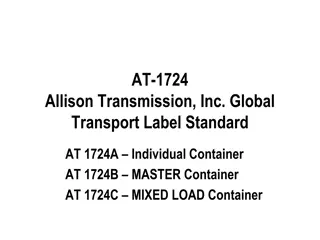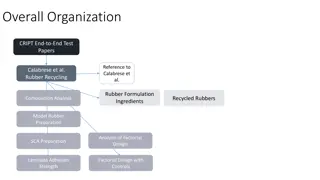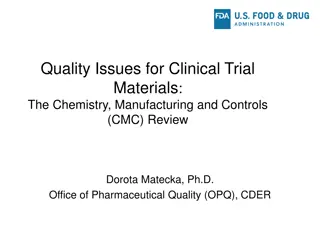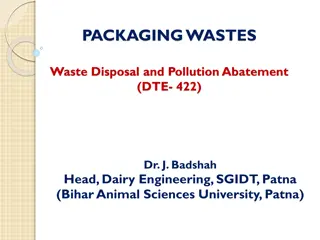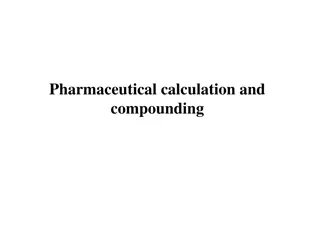Quality Control Tests for Containers, Rubber Closures, and Packaging Materials in Pharmaceutical Industry
Quality control testing is essential for containers, rubber closures, and secondary packaging materials in the pharmaceutical industry to ensure product protection, identification, and presentation. Various materials like glass, plastic, metal, and rubber are used for containers and closures, each having specific characteristics for different applications. Different types of packaging, including primary, secondary, and tertiary, play crucial roles in product safety and handling. The choice of packaging material depends on factors like protection requirements, dosage form compatibility, convenience, filling method, sterilization, and cost considerations. Understanding the quality control tests for these components is vital for ensuring the integrity of pharmaceutical products.
Download Presentation

Please find below an Image/Link to download the presentation.
The content on the website is provided AS IS for your information and personal use only. It may not be sold, licensed, or shared on other websites without obtaining consent from the author. Download presentation by click this link. If you encounter any issues during the download, it is possible that the publisher has removed the file from their server.
E N D
Presentation Transcript
B.PHARM. 6thSEMESTER UNIT III Quality Control: Quality control test for containers, rubber closures and secondary packing materials. 1
QC of Packaging materials Protection Information about product Packaging material provides Presentation Identification 2
PARTS OF PACKAGE & PACKAGING MATERIALS Container Box closures Types Carton outer 3
Material for containers Glass Plastic Container Paper Metal 4
Material for closures Glass cork Plastic closures Rubber Metal 5
Q.C. Tests for containers & closures Container: is article that contains/intended to contain drug substance/product and is/may be in direct contact with it. Closure: It is also part of container May be made of Glass, plastic, metal 6
Metal Closure Container Plastic 7
TYPES OF PACKAGING First envelop of product to hold. Smallest unit of use mostly, Ex. Aerosol spray can, blister pack, bottle ampoules, vials, polymer coated foils Primary It is outside the primary packaging, used to group primary package together Ex. Boxes, Cartons, Labels, Leaflets Secondary Used to bulk handling & shipping Ex. Barrel, Container, Edge protector Tertiary 8
Choice of Packaging material will depend on Degree of Protection Required Compatibility with the dosage Form Convenience to customer: Size, weight of dosage form Filling Method Sterilization method employed & cost 10
Type of Glass 4 types of Glass Type II Treated Soda lime Type IV Soda Type I Borosilicate Type III Soda lime Moderate hydrolytic resistance, Used for Non aq. Liq. or powders Soda glass Non parenteral Usage High hydrolytic resistance used for injectables 11
Type I Type II Lecture 2 Unit III Removal of Alkalinity by Boric oxide to neutralized Oxide of K / Na Made of commercial soda lime, de-alkalized or treated to remove surface alkali Highly resistant glass High melting point, can with stand temperatures De-alkalization is Sulphur treatment More chemically inert Resist strong acids, alkalis, various solvents, Reduced leaching Sulphur neutralizes alkali oxides on surface- Makes glass more inert chemically Used for alkali sensitive products, infusion fluids, blood & plasma, Large volume containers Laboratory use for injection & Water for injection 12
Plastics Types of Plastics Definition Group of substances, from natural/ synthetic origin, consist of mainly polymers of high molecular weight, molded into shape or desired form by heat & pressure Thermosetting Type Thermoplastics Type On heating softens to viscous fluid, hardens again on cooling If heated, become flexible, but don t become liquid Polyethylene, PVC, Polystyrene, Nylon, PET, etc. Ex. Urea HCHO, phenol HCHO, Epoxy resins, Polyurethanes etc 13
Metals Rubber Used for closure construction Al, Tin Plated Steel, SS, Tin impermeable to light, moisture, gases Ex. Vials, transfusion fluid/ dropping bottles Butyl rubber, Nitrile , Chloroprene, silicon rubbers Collapsible metal tubes 14
TAMPER RESISTANT PACKAGING Film wrappers- cellophane, polypropylene, thermoplastic Blister package- heat softened sheet of thermoplastic resin, PVC, Polyethylene combinations, polystyrene, PP Strip package- Paper, PE, Foil, PVC Bubble package or wrap- transparent plastic, for protection Shrink seals: PVC Paper Plastic pouches Bottle seals- Two sheets of glassine paper (resist air, water, grease, used for separation) Tape seals- High density light wt. paper with poor tear strength Breakable caps- Aluminum shells, breaks when cap is screwed Sealed tubes Aerosol containers 15
Quality control Testing & Standards Test for isolated pack material- or components Entire pack- Final Package Mechanical- for outer packing, to protect from transportation hazards standard test procedures, effect of different materials to prevent the damage to product Chemical test- pH of materials, Cl, SO4 in paper, board, alkalinity of glass, compatability test Mechanical Test- effect of creasing, folding etc. Environmental- Closures tested for water vapour transmission Test samples are subjected to environment artificially and evaluation is done Environmental Test: absorption of water, permeability to vapors, gases, oils etc. Sensitivity to light 16
CHEMICAL TESTING OF GLASS CONTAINERS Tests Hydrolytic Resistance T Water Attack T Powdered GT Light Arsenic Test Transmission Average overflow volume is determined 121 C autoclaving 60 min Combined liquids 50ml Liq. +M red Titrate 0.01M HCl, Blank with D.H2O. Take difference For containers exposed with SO2, For surface alkali neutralization To increase Resistance of glass Test Done To determine if alkali leached from surface is with in limits Done by Acid base Titration Measures transmission with reference to air at 290nm to 450nm, For non colored containers : not more than 10% Colored containers: As per the standard Absorbance of test solution not more than absorbance obtained by 0.1 ml Arsenic standard solution 10ppm instead of 0.1 ppm for test solution Alkali components from glass containers like oxide of K, Na, Ca, Al etc. gets leached into purified water 17
Powdered Glass Test (PGT): Leaching of Alkali from glass Autoclaved at 121 C 2 C, 30 min Rinse the containers with PW Cool the solution & Decant to another flask 10 g sample in 250ml C Flask+ 50 ml H2O Wash again with 15 ml PW & Decant Dry with stream of clean air Ground the containers in mortar Titrate Decanted fluid with 0.02N H2SO4, M Red Wash with acetone 2-3 times Pass thru sieve no. 20 & 50 Powdered glass 18
RESULTS Glass Types Test Limits (ml of 0.02N H2SO4) TYPE I (highly resistant, Borosilicate) 1ml for all size glass containers 0.7ml for 100ml or less size TYPE II Treated soda lime 0.2 ml for over 100ml size glass Types OF Glass TYPE III Soda lime glass 8.5ml for all size glass TYPE NP General purpose soda lime 15ml for all size 19
HYDROLYTIC RESISTANCE This determines average overflow volume Number of Glass containers to be used for Hydrolytic Resistance Nominal capacity of container (ml) Number of containers to be used Volume of test solution to be used for titration (ml) Min. 10 50 5 Min. 5 50 6-30 Min. 3 100 30 20
HYDROLYTIC RESISTANCE PROCEDURE Reduce temp from 121 to 100 C over 40 min Req. no. of containers Stop autoclave Rinse- 3 times Fresh DW Maintain temp. at 121 C for 60 min Take out containers, cool Raise the temp. from 100 to 121 C over 20 min Combine all liquids, measure the volume Fill containers with DW 90% of their overflow volume Titrate 0.01M HCl, M Red, Blank, Diff. of readings vol. of HCl consumed by test Cover and seal Autoclave 21
Other Tests for Glass containers The containers are placed in upright position in a tray Assembly immersed in hot water for std. time, shifted to coldwater bath Examine the samples before & after test for any cracks outside Thermal Shock Test Annealing: process of slowly cooling hot glass objects when they are formed to relieve internal stress if any while mfg. Sample is examined by polarized light by polariscope or strain viewer. Compared against std. discs Annealing Test Filled Test bottle is placed in test chamber, applied sealing head & series of internal pressure in increments for a time interval Container burst pressure is recorded Internal Bursting Pressure Test Place bottle between fixed platform & hydraulic ramp platform Raise the ramp to apply vertical load Record the load by pressure gauge Vertical Load Test 22
Metal Container test for eye ointment Collect base of all tubes in the heated filter 50 metal tubes Apply suction Caps of cooled tubes are removed, uniform pressure applied at base of tube Cleaned by vibration/ blowing air Wash the filter & paper with chloroform Heated filter to temp. above the Melting range of ointment base Dry filter paper, mount between glasses Filled molten ointment base Metal Open end is closed, cooled overnight at 15- 20 C Examine under oblique light with magnifying glass bacteriological filter , 4.25cm filter paper of suitable porosity is taken 23
Metal Particle score Metal Particle Size 1mm 0.5 mm-1 mm 0.2mm-0.5mm 0.2mm Score 50 10 2 Nil Total Score 100 150 100-150 Result Lot passes Lot fails Repeat Test on another sample of 50 tubes The lot passes if sum of total scores in the two tests is than 150 points 24
Plastic container test for non injectable preparations Leakage Test: 10 containers filled with water, kept inverted at RT for 24 Hrs. No sign of leakage from any containers Collapsibility Test: At the required rate of flow & ambient Temp., container should yield at least 90% of its contents by collapsing inward during use Clarity Test: Unlabelled, non labelled, unmarked portion is selected. Portions are cut into strips with area of 20 sq.cm, Strips washed with DW , draining water. Strips with total area 1250 sq cm, in flask + 250ml DW, cover, Autoclave at121 C for 30 min. Blank Determination on DW in flask. Cool flask, extract examined. Should be Free from turbidly Non Volatile Residue Test: 100 ml extract of above CT, evaporated & dried to constant weight at 105C. Residue : not more than 12.5mg 25
Plastic containers for injectable preparations Leakage Test 10 containers Collapsibility Test Transparency Test 16 fold dilution of standard suspension Std. susp. : 1g hydrazine sulphate +DW to produce 100ml, 25 ml of this + 25 ml 10% w/v solution of hexamine 15 ml of above diluted to 1000ml with DW (std susp.) Fill 5 empty containers with susp. Cloudiness of each is compared with DW. If cloudiness matches with DW sample pasess Water vapour permeability Test 5 containers filled with a nominal volume of water, sealed, weighed, allowed to stand for 14 days at 60 5% RH & 20-25 C. After 14 days containers are reweighed . Loss in weight should not be more than 0.2% 26
Rubber Closure for containers for injectable preparations Wash the rubber closures by agitation 0.2% anionic surfactant at RT for 5 min Weight of container made upto original with adding water Cool Place in borosilicate glass container 200ml water/100 sq.cm. Decant the solution (Sol. A) Autoclave 119-121 C Dry the closures 64C- 66C, Pressure 0.7 kPa For 24 hrs Close the mouth of container with Al foil Weigh the container 27
Sterilization Test Sample closures should not soften/tacky, should be without any visual change after sterilization Fragmentation Test Done for closures intended for piercing by Hypodermic needle Close the vials with rubber closure, inj. 1ml water, remove 1 ml of air. Repeat for 4 times for each closure, piercing done at different sites No. of fragments visible are counted which is not more than 10 Self sealability (done for multi dose container closures) 10 vials, filled with water, close the vials with rubber closures, pierce each with hypodermic needle, immerse the vials upright in 01.% w/v methylene blue sol. Reduce ext. pressure by 27 kPa for 10 min. Restore the atm. Pressure, leave vials for 30 min. in sol. Rinse vials from outside, No traces of colored solu. Inside - Passes 28
pH of aqueous extract Sol. A 20ml + 0.1 ml Bromo thymol blue Not more than 0.8 ml of 0.01M HCl or 0.3 ml of 0.01M NaOH is required to change color of solution to yellow or blue resp. Heavy Metals 20ml Solution A Complies with Limit Test as per I.P. Residue on Evaporation 50 ml of solution A evaporated to dryness on water bath & dried at 105 C Residue weighs not more than 4 mg 29
SECONDARY PACKAGING MATERIALS Paper & board should pass following Test carried at Temp. 23 C 1 C, RH: 50% 2% Moisture content Air permeability Stiffness Density Tear Strength Creasibility Folding endurance Tensile strength Burst resistance Grammage (g/m2) Puncture Resistance Cobb Test (g/m2) 30
Test for Paper & boards S N Test Description 1 Moisture content The material moisture measured at specific temperature 2 Folding Endurance The piece is folded back & forth until it ruptures 3 Density of material Done for rigid cellular materials 4 Air permeability For using light weight uncoated paper on machine with vacuum pick system, expressed in m /pa/s Maximum force /unit width a paper or board can withstand 5 Tensile Strength 6 Tear Strength Mean force required to continue tearing of an initial cut in a single sheet paper Maximum uniformly distributed hydraulic pressure applied at right angles which a test piece can bear till it burst Energy required for initial puncture 7 Burst Resistance 8 Puncture Resistance 9 Stiffness Degree of resistance offered by the test sample when it is bent 10 Cobb Test Test for water absorbency 31
Test for Paper & boards SN Test Description 11 Gammage Determines wt. of material/ unit area of sample 12 Creasibility For creasing quality of board within range of 300-1000 m 13 Paper caliper Thickness of single sheet between one surface & other 14 Nitrogenous constituents in sample pH, Cl/ SO4 Applicable to substances with high affinity for acid dyes 15 pH determination helps to decide the life of paper/board 16 Pick Test Specific amt. of oil added to printing system & printed on test piece. The surface is examined for any signs of pick Test piece immersed in water to determine the wet burst of sample 17 Wet burst Test 18 Ash Test To determine ash content of paper / board 19 Ink Absorbency Ink absorbency of paper or board by K & N ink 20 Roughness/ Smoothness Deciding test for printability of paper 32
QC TEST FOR CARTONS Compression: To asses the strength of upright package to ensure the degree of protection it will provide Joint Shear Test: For testing the glued lap seam on the side of a carton for strength of adhesive using a tensile testing machine. To ensure that correct adhesive has been used to glue the cardboard Crease Stiffness: Crease recovery test. Testing a piece of carton by folding it at 90 . When force is removed the folds try to recover the original positions Carton Opening Force: Used to hold flat carton as delivered by its creases between thumb & first finger press. It should open without any much force Coefficient of Friction: Static & kinetic coefficients are determined by sliding specimen over itself under specific test conditions 33
REFERENCES 1. B.P. Nagori, Ajay Gaur, Renu Solanki, Vipin Mathur, Pharmaceutical Quality Assurance, Scientific Publishers, Delhi, 2018. 2. Swarnali Das Paul, Gunjan Jeswani, Concise course in Pharmaceutical Quality Assurance, S. Vikas and company, Punjab. 2019. 3. Jasuja S, Kataria MK, Quality control testing of packaging materials, Pharmatutor, Ref. I.D. 4. Zadbuke N, Shahi S, Gulecha B, Padalkar A, Thube M. Recent trends and future of pharmaceutical packaging technology. J Pharm Bioallied Sci. 2013;5(2):98 110. doi:10.4103/0975- 7406.111820 5. www.google.com 34
